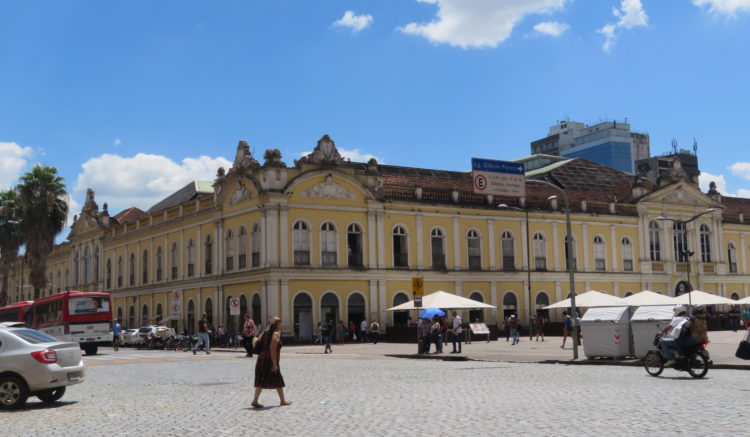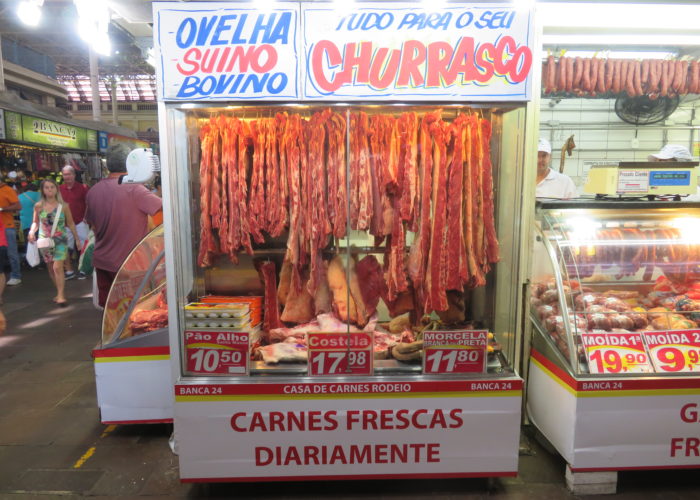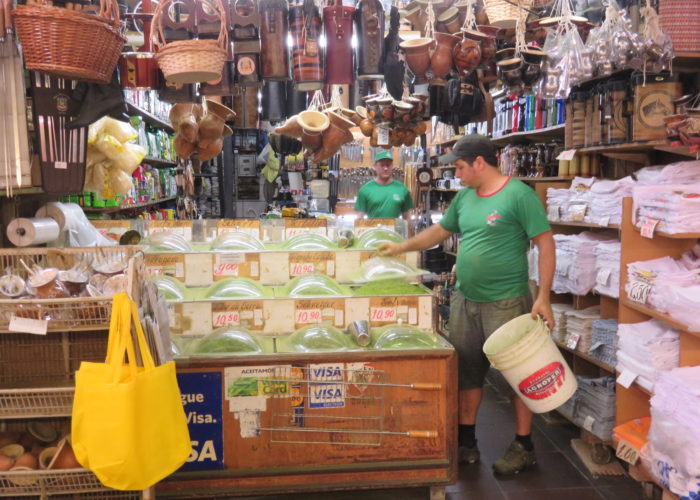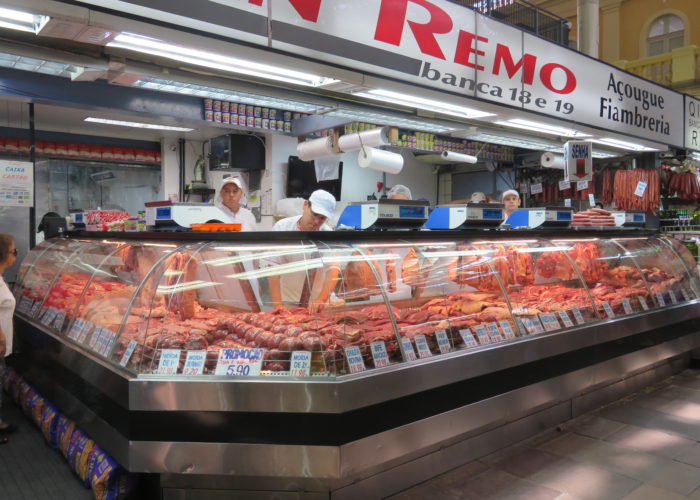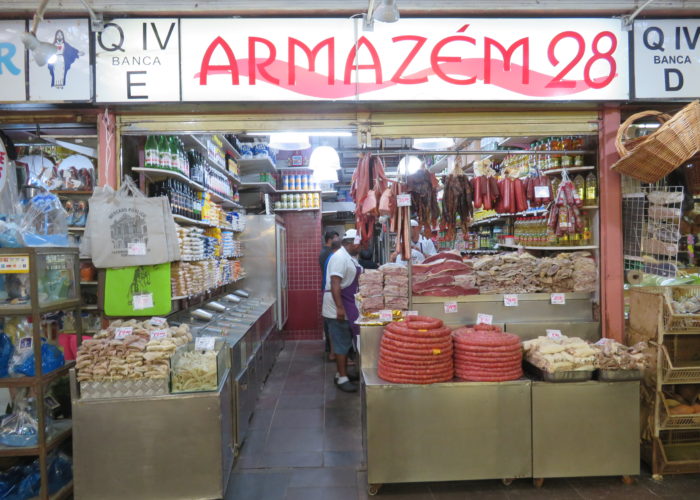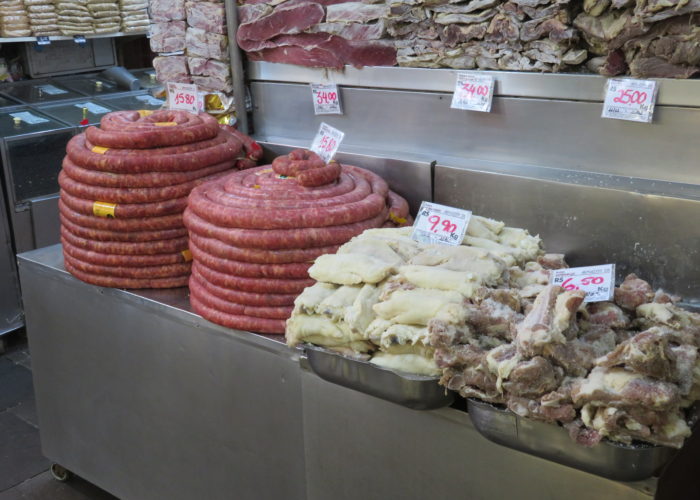Our journey round Southern Brazil was completed in Porto Alegre, another of the World Cup Host Cities and one of the most prosperous in Brazil. Porto Alegre is considered the home of the Brazilian churrascaria and much of Brazil’s beef exports flow through the city, which has many substantial grand commercial buildings in the centre that were built up from the wealth generated by the agricultural exports and related industries. Brazil’s Southern States have to be some of the most fertile in the world.

The Central Municipal Market is a grand building and acts as the focal point of the City Centre. The produce sold in the market is of the highest quality, with butchers, fishmongers, greengrocers all competing with each other for the best quality produce. Not only does the food look really impressive, the quantity is equally so. In addition to the standard butchers and fishmongers there are specialist purveyors of offal, dried fish and all sorts of food products. In the centre of the market there is a roped off area whereby people leave coins for those in need of support for food etc. to simply pick up in a dignified manner rather than begging on the street. It is supervised by a security guard and seems to work really well. Restaurants and food shops also are seen to regularly donate food too, with those in need being given bags of food.
Porto Alegre has a distinctly European feel, and has a lot of similarities with Argentina to the South. For example in the Central Market there are a number of specialist mate stores, selling all the paraphernalia required to consume mate as well as many different types of mate as you can see in the above photograph.
Being the home of the Brazilian churrascaria, we went to one of the top steak restaurants, NB Steak House, on our last day and had their tasting menu. Pride of place came the beef, principally British breeds and the cuts included, Top Sirloin, Bottom Sirloin, Filet, Ribeye, Beef Ribs, Chorizo, Rump, their own speciality NB Steak as well as Lamb, Chicken Thighs and Hearts, Pork Loin and Pork Rib. A real carnivore experience. Also in Brazil beef is much cheaper than other meats like chicken. Surprisingly for a Saturday night, the cavernous restaurant had only five other tables occupied. There were more staff than punters.
 Many of the grand commercial buildings, including banks, the post office and the port authority buildings have been turned into specialist museums for art and history, rather than bars back home. The picture above shows the grand banking hall. Furthermore they are also free to visit.
Many of the grand commercial buildings, including banks, the post office and the port authority buildings have been turned into specialist museums for art and history, rather than bars back home. The picture above shows the grand banking hall. Furthermore they are also free to visit.
Like most South American cities the principal shops have all moved out of the City Centre and into purpose built shopping malls, which benefit from air conditioning and security. This is particularly marked on Sundays when the market is closed as are all the other shops in the Centre. In some ways the City Centre feels like a throw back to the 1970s with so little open. However the malls outside the centre are fully open for business and they are where the locals do they shopping. I suspect in ten or so years time the city centre may begin to be repopulated.

In the Moinhos de Vento neighbourhood, one of the most prosperous in Porto Alegre there are number of impressive tree lined avenues, where the mature trees provide an elegant canopy over the street. In the summer months these streets are pleasantly cool as the outside temperature gets well into the mid 30s. Rua Gonçalo de Carvalho in this neighbourhood has been dubbed “the most beautiful street in the world”, while that is clearly stretching it, the tipuana trees that provide the canopy over the street are impressive.

Another little known fact is that Brazil contributed troops, who were known as “the smoking cobras”, to the Italian Campaign in World War 2. In Parque Farroupilha stands a war memorial, that could have been designed by Lutyens to commemorate the fallen in that campaign. Indeed Brazil was the only ally from South America to provide troops to the war effort.
Below the swarm of orange taxis outside the bus station does make you wonder how they can all make a decent living in that it must take them an hour or so to work their way through the rank. Also when you take away differences of colour all the taxis look the same, though there are a number of different makes of vehicle.

Date: 15/02/2018 to 18/02/2018
